Status Closed | Opening date 1978 (1978) | |
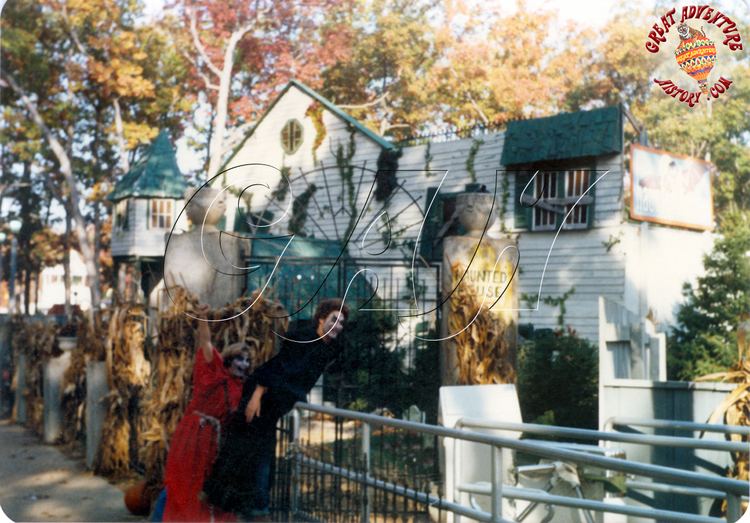 | ||
Closing date May 11, 1984 (1984-05-11) Similar Rolling Thunder, Runaway Mine Train, Safari Off Road Adventure, Green Lantern, Bizarro | ||
The Haunted Castle at Six Flags Great Adventure was a haunted attraction at Six Flags Great Adventure amusement park in Jackson Township, New Jersey. On May 11, 1984, eight teenage visitors were trapped in this attraction and lost their lives when the structure was destroyed by fire. Six Flags Great Adventure and its parent company Six Flags were indicted for aggravated manslaughter, accused of recklessly causing the deaths by taking inadequate precautions against a fire. In the trial, the prosecution argued that repeated warnings by safety consultants to install sprinklers or smoke alarms had been ignored. The defendants denied any culpability, and contended that the fire was arson and that no precautions would have saved lives. The trial jury found the defendants not guilty.
Contents
- Operation
- Construction and history
- Materials
- 1984 fire
- The investigation
- Legal aftermath
- Criminal trial
- Prosecution case
- Defense
- Jury findings
- Other legal aspects
- Safety improvements
- Fatalities
- Questioning the report
- References

Operation
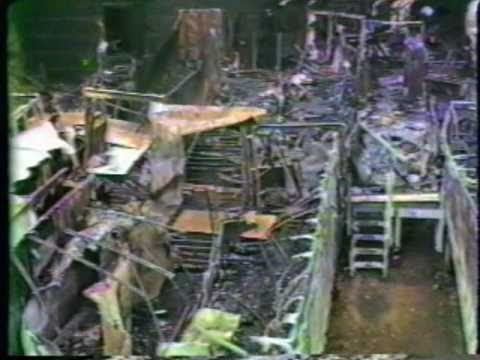
The purpose of the Haunted castle walk-through dark ride was to entertain its customers by frightening them. Exterior decorations included plastic monsters, skulls and other features meant to create a frightening atmosphere. A facade of false turrets and towers lent the illusion of height to the one-story structure, completing the look of a forbidding medieval castle. After crossing a drawbridge over the surrounding moat, visitors entered the castle and felt their way along a 450-foot (140 m)-long convoluted path of dim corridors, occasionally being startled when employee actors dressed as Dracula, Frankenstein's monster and other creatures jumped from hiding. Various theatrical props and exhibits were in view, including coffins, ghoulish mannequins, hanging spider webs and skeletons. Strobe lights and eerie sounds completed the scene.
Construction and history
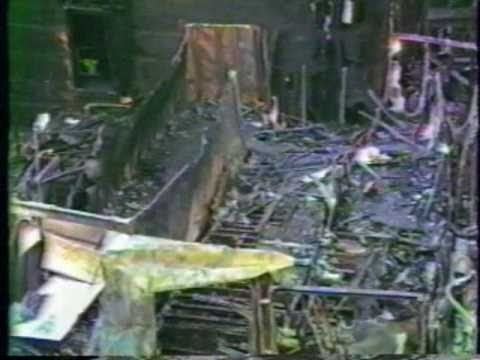
Originally constructed of four aluminum semi-trailers when it opened in 1978, the castle was expanded to 17 interconnected trailers in 1979, with separate corridors and a common control room in the center. Only one side, with 9 of the 17 trailers, was in use at the time of the fire.
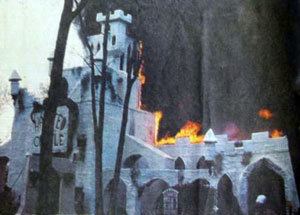
During the subsequent criminal trial, the Jackson Township fire inspector testified that he had never inspected the castle. The township considered the castle a "temporary structure," even after it had been at the park for five years, based on the fact that the trailers were on wheels. The castle lacked a building permit or certificate of occupancy, and had no sprinklers or alarms despite repeated recommendations for them by the park's own safety consultants.
Materials
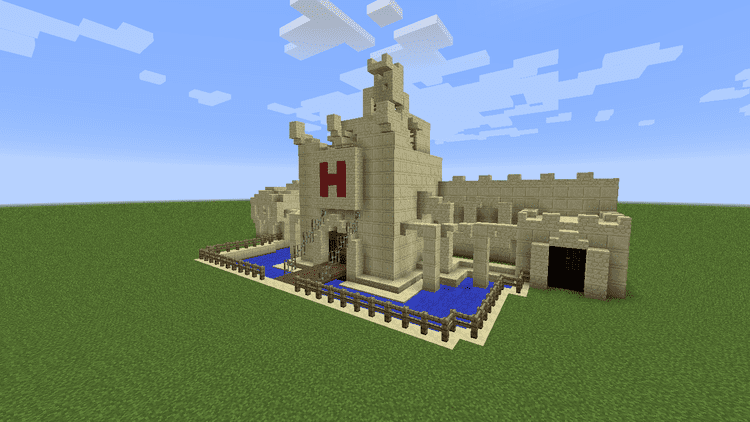
The castle's aluminum trailers were linked by plywood partitions to create a complex maze. Attached to its exterior were painted turrets and towers of plywood on wooden frames. Inside, the materials used included foam rubber, various fabrics and plastics, plywood and tar paper. Wax mannequins were used as props.
1984 fire
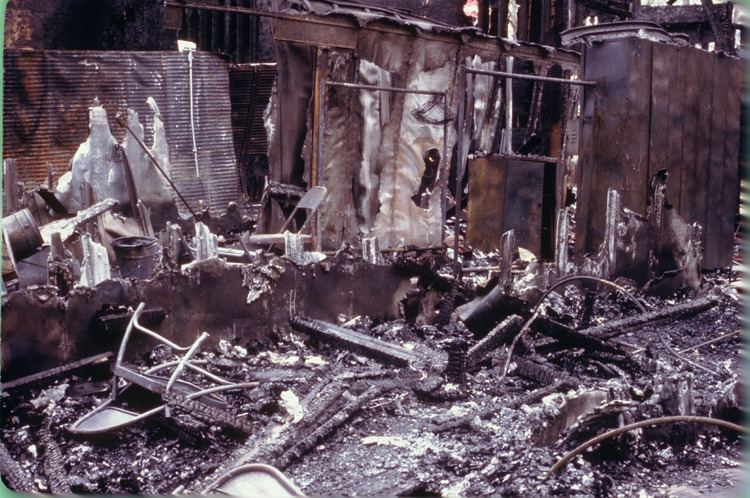
The fire started at 6:35 p.m. on a Friday evening on May 11, 1984. Fanned by outside air conditioners that continued to push air up through the floor vents, it spread rapidly due to the use of flammable building materials. About 29 people were in the attraction when the fire started. Fourteen, including four park employees, escaped. Seven were treated for smoke inhalation at an area hospital. Eight teenagers from one group of nine that entered together were trapped and killed by asphyxiation. The only survivor of the group, 15-year-old Suzette Elliott, was carried to safety by a park employee.
One witness, whose group entered the attraction three to five minutes behind the victim group, later testified that when she reached a display called the Hunchback, she saw flames coming from around a bend beyond the display. She thought it was part of the show, but then smelled smoke and realized the flames were real. Her group started shouting "fire!" and ran back to the entrance, bumping into walls.
Firefighters from 11 surrounding communities responded, and the fire was declared under control at 7:45 p.m. The park remained open during the fire, and closed at 8:00 p.m., two hours early. No one realized that lives were lost until later that night, when firefighters searched in one of the burnt-out trailers discovering the eight deceased teenagers, who were burnt beyond recognition and at first thought to be mannequins. Their causes of death were smoke inhalation and carbon monoxide poisoning. These eight teenage corpses were placed into white body bags to let emergency personnel differentiate real corpses and charred mannequins in the dark.
The investigation
The fire spotlighted a complex collection of local, state and federal laws. New Jersey's Department of Labor and Industries inspects the safety of rides, such as roller coasters and ferris wheels. Locally, municipalities enforce state and local building codes governing fire safety and electrical wiring. In turn, the state's Department of Community Affairs is responsible for ensuring that municipalities enforce the codes. Finally, the Federal Occupational Safety and Health Administration (OSHA) is responsible for monitoring employee safety. A state panel investigating the fire said that the regulatory system had failed at almost every level; and that the Haunted Castle had been in violation of a dozen state fire codes.
The panel said the state's Uniform Construction Code required the owners to install smoke detectors and several other common safety devices before the castle opened. A spokesman for the local volunteer fire department said it had not enforced the state requirement for smoke detectors because the township's building inspector said that the code did not apply because the castle was a temporary structure.
Eight days after the fire, a statement by the Ocean County Prosecutor's Office said a 13-year-old boy had called the police after hearing radio reports that investigators were looking for witnesses. The boy told the police that he had been befriended by a 14-year-old boy at the castle's entrance. He said the older youth, who appeared to be familiar with the castle, offered to guide him through. He said the older youth used a cigarette lighter to find his way down a long corridor that was dark because of a malfunctioning strobe light, and eventually bumped into and ignited a foam-rubber wall pad. The prosecutor exonerated the older youth, who has never been identified, of any criminal wrongdoing.
Legal aftermath
On September 14, 1984, a grand jury in Toms River, New Jersey, indicted Six Flags Great Adventure and its parent company, Six Flags, on a charge of aggravated manslaughter, for "recklessly causing the deaths under circumstances manifesting extreme indifference to human life." The indictment also charged two park executives, the general manager at the time of the fire and his predecessor, with manslaughter for reckless conduct in ignoring repeated warnings of safety violations.
Criminal trial
The criminal trial began in New Jersey Superior Court in Toms River on May 29, 1985. The prosecution argued that repeated warnings by safety consultants to install sprinklers or smoke alarms had been ignored. The defendants denied any culpability, and contended that the fire was arson and that no precautions would have saved lives.
Prosecution case
The prosecution called as witnesses fire-prevention consultants who had inspected the castle and recommended the installation of sprinklers or smoke alarms; and told the trial jury that after five years of semiannual inspections, the devices were not in place when the attraction burned. Shift managers of the attraction called as witnesses testified that "none of the exit lights were working, bulbs were missing from other lights and there were no fire alarms, despite a history of patrons using matches and cigarette lighters in the dark corridors"; and that their pleas for safety precautions had been rejected by management as too expensive. They also testified that a ripped "crash pad" in the corridor had exposed foam rubber padding.
The boy who had come forward as a witness during the initial investigation repeated what he had told investigators earlier, testifying for the prosecution that he had seen another boy his age, a boy he did not know, accidentally set the fire with a cigarette lighter by brushing its flame against a foam wall pad. According to news reports of the trial, no such boy was ever found, and no other witness testified to seeing such a boy. Under cross-examination by the defense, the witness denied starting the fire himself.
Defense
The defense denied any culpability, saying that company executives had carefully considered all safety recommendations, acting on some and rejecting others; and contending that the fire was arson and that no precautions would have saved lives in a fire where an accelerant was used. A defense forensic pathologist said arson might be the cause, saying that "high levels" of benzene in the victims' blood "could indicate some sinister reason for the fire." However, another defense witness said there were no burn patterns or other evidence of an accelerant.
Park officials testified that smoke alarms had been installed, but the park was unable to control vandalism to them and decided not to reinstall them after 1979. A park official testified that having an employee assigned to walk continually through the attraction was a good alternative to the smoke alarms. A top fire-safety official testifying for the defense said that sprinklers and smoke detectors might have saved part of the structure, but would not have saved lives because by then "you would have had lethal combustion products throughout the facility", suffocating the victims. His testimony was later criticised by other fire-safety experts as undermining efforts to advance sprinkler legislation.
Jury findings
The jury, after an eight-week trial and 13 hours of deliberation, found the two companies not guilty of the charges. Interviewed after the trial, the jury foreman blamed Jackson Township officials for repeatedly allowing the castle to slip through cracks in the fire code. A second juror disagreed, saying that township officials were not derelict. Both jurors held the two companies blameless because they had been told by township officials that they needed no permit or sprinklers.
Other legal aspects
The two park executives charged separately with manslaughter avoided trial and possible imprisonment by entering a pretrial intervention program that allowed them to perform community service.
The families of the eight victims filed civil suits against the machine manufacturer Chance Rides and owner of Six Flags; Six Flags; and the castle's builder, the Haunted House Company of East Orange, charging manslaughter and aggravated manslaughter. Seven of the eight families later settled out of court for $2.5 million each; the eighth family chose to go to trial and was awarded $750,000.
Safety improvements
Immediately after the fire, several other New Jersey haunted-house attractions were closed pending fire inspections, including the multi-trailer Doorway to Hell on Casino Pier in Seaside Heights, New Jersey, built by the same company. New Jersey and other states passed new fire-safety laws for dark rides and "any structure that intentionally disorients".
Park attendance fell sharply for the rest of the year, finishing 15 percent below the 3.3 million of the year preceding. Park officials said pre-fire attendance levels were restored the next year after they reassured the public that the park was made safer by the addition of $5.2 million worth of sprinklers and computerized smoke and heat detectors, while industry sources have reported that ensuing poor attendance almost caused the park to close in 1987.
Fatalities
Note: The teenagers Rodriguez, Ruiz, Valentin, Jr. and Carrion, Jr. were students from Franklin K. Lane High School at the time of their deaths, but Harrison was already a graduate.
Questioning the report
An independent film titled Doorway to Hell? The Mystery and Controversy Surrounding the Fire at the Haunted Castle was produced in 2003 by Peter James Smith, a long-time patron of the Haunted Castle. Smith's documentary, which won a "Best Research" award at the 2004 New York International Independent Film and Video Festival, documents the fire, investigation and trial, and questions the official report's finding that the fire was accidental. Smith speaks of an "emotionally disturbed" youth with a history of setting fires who "kept playing with a lighter in his pocket". He says the youth was seen exiting the attraction as the fire broke out and was later questioned by police but not charged due to lack of evidence.
The film says that two earlier visitors on the day of the fire reported seeing a chained exit door, but were not called as witnesses. (Ocean County authorities reported no physical evidence of chained doors and dismissed such claims.) Some visitors and employees Smith interviewed thought doors were blocked at times for the security of actors and to keep actors from going outside to smoke cigarettes or marijuana.
Smith also says that diagrams of the castle and its exits used in the trial were inaccurate, and did not show a metal fence erected to protect actors from hostile guests, something that would have made escape more difficult. Great Adventure officials declined to comment on the film.
